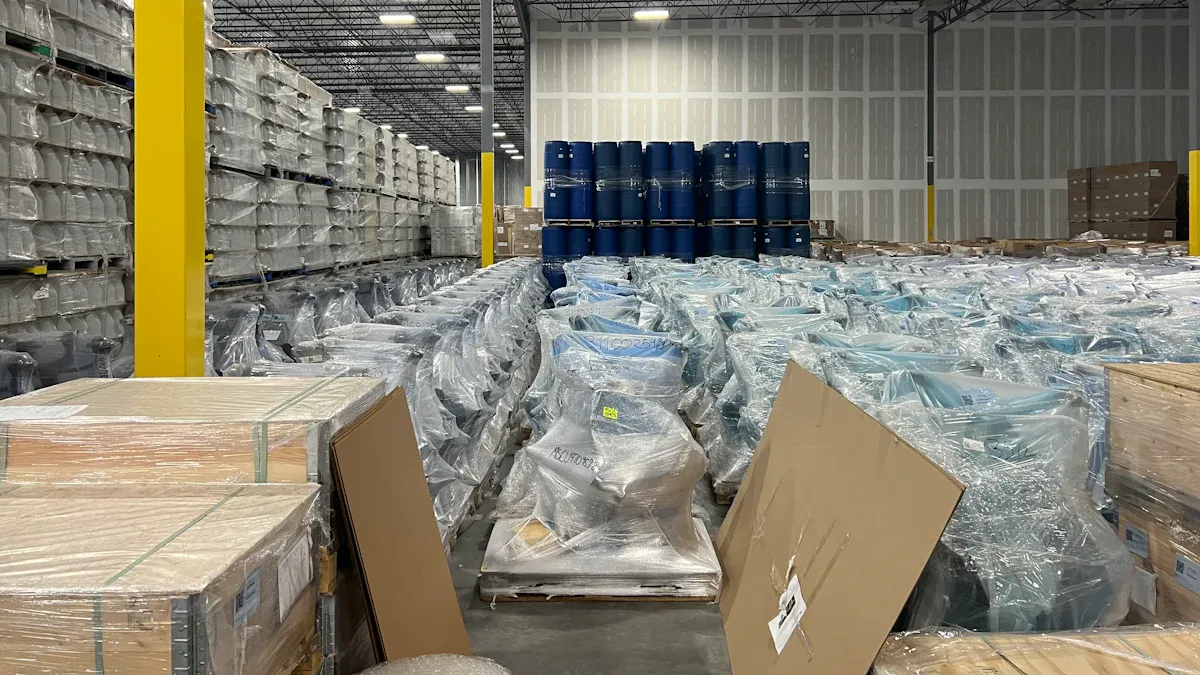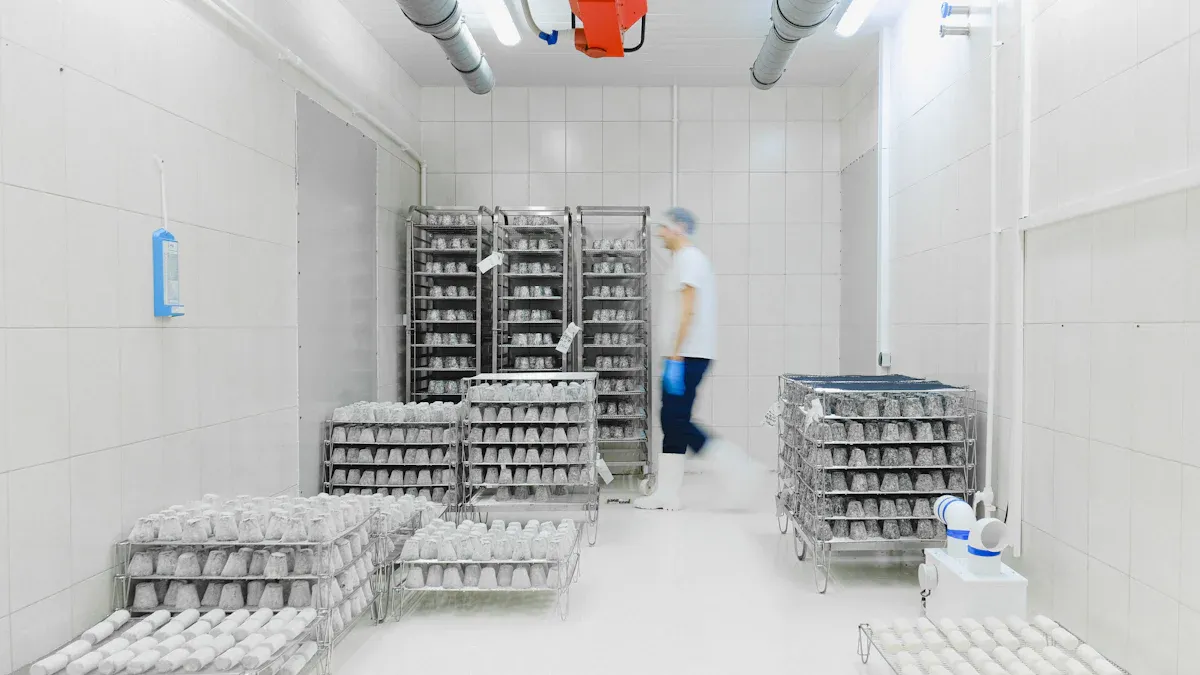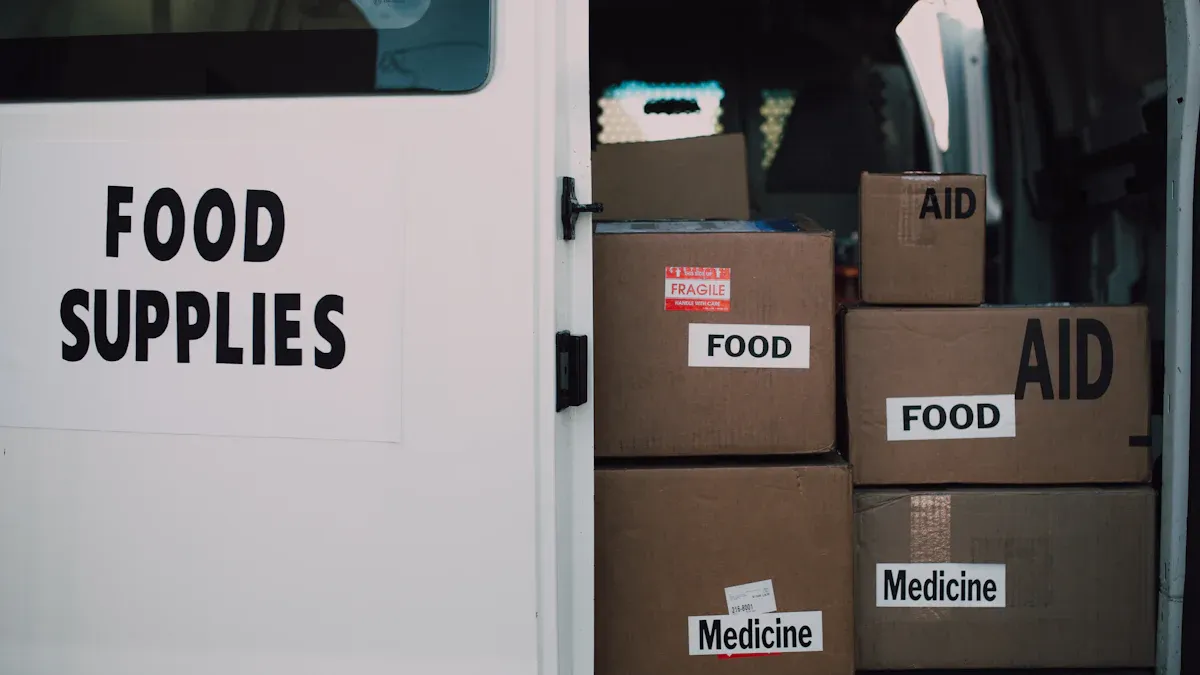How to Enhance Cold Storage Operations with Practical Efficiency Tips

Cold storage operations demand a meticulous balance between safety and efficiency to ensure smooth functioning. You must prioritize worker well-being and product integrity to mitigate risks and maintain compliance. For instance, regulatory requirements mandate safe chemical handling and regular audits to prevent hazardous incidents. Proper training on equipment use and emergency protocols further enhances operational safety.
Adopting practical strategies can transform your warehouse into a high-performing facility. Automation and IoT technologies enable real-time monitoring, reducing human error and improving efficiency. Additionally, advanced storage systems optimize space utilization, ensuring better inventory management and cost savings. These measures not only safeguard your operations but also drive long-term success.
Safety Tips for Cold Storage Operations

Worker Safety in Cold Storage
Importance of proper protective gear
Ensuring worker safety in cold storage environments begins with proper protective gear. You must provide employees with insulated clothing, gloves, and boots designed to withstand cold temperatures. These items protect against frostbite and hypothermia while maintaining flexibility for movement. However, bulky gear can limit mobility, increasing the risk of accidents. To address this, select ergonomic designs that balance protection and comfort. Additionally, fogged goggles or poor lighting can reduce visibility, so ensure workers have access to anti-fog eyewear and well-lit workspaces.
Emergency protocols and first aid measures
Accidents can happen even in the most well-maintained cold storage warehouse. Establishing clear emergency protocols is essential. Train your team to respond quickly to incidents like slips, falls, or exposure-related health risks. Provide a warm break room where employees can recover from cold exposure. Stock first aid kits with supplies tailored to cold-related injuries, such as thermal blankets and warming packs. Regular drills reinforce these protocols, ensuring everyone knows their role during emergencies.
Regular Inspections in Cold Storage Warehousing
Identifying and mitigating hazards
Regular inspections are vital for maintaining a safe warehouse environment. Conduct safety inspections using a comprehensive safety checklist that includes pallet rack configurations, pest control, and slip hazards. Employ qualified inspectors to identify potential issues and recommend improvements. This proactive approach minimizes risks and ensures compliance with safety standards.
Ensuring equipment safety through maintenance
Equipment failures can lead to serious hazards in cold storage warehousing. Schedule routine maintenance to keep refrigeration systems, forklifts, and other machinery in optimal condition. Accurate record-keeping, including temperature logs, helps track performance and identify issues early. Automated sensors can simplify this process by providing real-time data and alerts for any deviations.
Temperature Monitoring for Safety
Preventing risks like frostbite and hypothermia
Cold temperatures pose significant health risks to workers. Limit exposure times and provide warm-up breaks to reduce the likelihood of frostbite or hypothermia. Sophisticated temperature monitoring systems can help maintain a safe working environment by ensuring consistent conditions throughout the facility.
Maintaining product safety with consistent temperatures
Temperature control is critical for product integrity. Fluctuations can lead to spoilage or quality degradation, especially for perishable goods. Advanced monitoring systems streamline operations by logging temperature data and alerting you to any irregularities. These systems also ensure compliance with regulations like the Food Safety Modernization Act (FSMA).
"Temperature fluctuations can lead to spoilage, deterioration, or complete loss of perishable goods. Factors such as faulty equipment, power outages, or inadequate insulation can disrupt optimal temperature conditions."
Benefit | Description |
|---|---|
Helps streamline the distribution process for temperature-sensitive products. | |
Compliance Readiness | Retains a continuous log of temperature data for compliance purposes. |
Consumer Safety | Ensures that medications and perishable food are stored at safe temperatures to prevent harm. |
Efficiency Tips for Cold Storage Systems
Energy-Saving Strategies for Cold Storage
Benefits of energy-efficient lighting and equipment
Energy-efficient lighting and equipment can significantly reduce operational costs in your cold storage warehouse. LED lighting, for instance, consumes 75% less energy than traditional lighting and generates minimal heat, which helps maintain cold temperatures without overburdening refrigeration systems. Additionally, LED lights last up to 75,000 hours, reducing replacement costs and enhancing sustainability. Pairing these with energy-efficient refrigeration systems further minimizes energy consumption and carbon emissions, ensuring long-term savings and environmental benefits.
Smart temperature controls for optimal energy use
Smart temperature controls are essential for maximizing efficiency in cold storage operations. These systems use advanced sensors and algorithms to monitor and adjust cooling levels based on real-time conditions. By implementing energy management systems, you can optimize cooling operations, reduce energy waste, and take advantage of off-peak pricing. Continuous commissioning, which relies on data analytics, can also identify inefficiencies and implement energy conservation measures, ensuring your warehouse operates at peak efficiency.
Equipment Optimization in Cold Storage
Regular servicing to enhance performance
Regular servicing of equipment is crucial for maintaining efficiency and safety in cold storage warehousing. Routine maintenance ensures refrigeration systems, forklifts, and other machinery operate at optimal levels, reducing downtime and preventing costly repairs. Accurate record-keeping, including maintenance logs, helps track performance and identify potential issues early. This proactive approach not only enhances productivity but also extends the lifespan of your equipment.
Upgrading to high-efficiency refrigeration systems
Investing in energy-efficient refrigeration systems is one of the most impactful ways to improve cold storage operations. Modern systems use advanced insulation materials and innovative cooling technologies to lower energy consumption. Upgrades like these not only reduce operational costs but also improve temperature consistency, ensuring product safety. High-efficiency systems also contribute to sustainability by minimizing carbon emissions, making them a smart choice for long-term success.
Space Utilization in Cold Storage Warehousing
Organizing inventory for better airflow
Proper inventory organization plays a vital role in optimizing space utilization and maintaining efficiency. Arrange products to allow adequate airflow, which helps refrigeration systems maintain consistent temperatures. Implementing efficient slotting techniques, such as ABC analysis, categorizes items based on demand frequency, ensuring faster access to high-priority goods. This approach reduces energy waste and improves overall warehouse operations.
Maximizing storage capacity with advanced racking systems
Advanced racking systems are a game-changer for maximizing efficiency in cold storage warehousing. Drive-in racking, for example, allows pallets to be stored multiple positions deep, reducing aisle space and increasing storage capacity by up to 75%. Facilities like Coloma Frozen Foods have demonstrated the effectiveness of these systems, achieving significant cost savings in labor, energy, and maintenance. By optimizing vertical storage and using specialized racks, you can store more products within the same footprint, enhancing both capacity and efficiency.
Training and Compliance in Cold Storage
Employee Training for Safety and Efficiency
Educating workers on safety protocols
Effective employee training is the backbone of safe and efficient cold storage operations. You should focus on hazard awareness, proper use of personal protective equipment, and emergency procedures. Workers must understand how to spot condensation and ice build-up, which can lead to slips or equipment malfunctions. Training should also cover hygiene standards and compliance with regulations to ensure a safe working environment.
Incorporating tailored training programs can address specific tasks like safe lifting techniques or handling temperature-sensitive products. Visual aids, such as posters and videos, enhance understanding by illustrating correct practices. Regular refreshers and hands-on demonstrations reinforce critical knowledge, ensuring workers stay updated on safety protocols. Leadership involvement, where managers model best practices, fosters a culture of safety and accountability.
Training on equipment handling and maintenance
Proper equipment handling and maintenance training is essential for operational efficiency. Workers must learn the functions of machinery used in the warehouse, including forklifts and refrigeration systems. Cleaning and maintaining key areas, such as battery and refrigerant stations, should also be part of the curriculum. These practices reduce downtime and prevent costly repairs.
You can enhance training by using real-world scenarios to demonstrate the importance of regular inspections and maintenance. This approach not only improves equipment performance but also minimizes risks to employee health and safety.
Compliance with Industry Standards
Meeting food safety regulations
Compliance with food safety regulations is non-negotiable in cold storage management best practices. Facilities must adhere to standards like the Clean Air Act and OSHA’s Process Safety Management to ensure the safe handling of chemicals, such as ammonia. These regulations prevent hazardous incidents that could endanger health and safety.
Temperature and humidity regulation is another critical compliance area. Different products require specific conditions to maintain quality. Accurate labeling systems and product traceability further ensure adherence to food safety standards, enhancing customer satisfaction and operational efficiency.
Conducting regular audits and inspections
Regular audits and inspections are vital for maintaining compliance in cold storage warehousing. These evaluations uncover weaknesses in security controls, policies, and procedures. They also identify areas for improvement and recommend corrective actions. For example, process safety maintenance audits prevent incidents and improve operational performance.
By conducting compliance audits, you can minimize risks to employees and the public while avoiding hefty fines or penalties. These inspections ensure your warehouse operates within industry standards, safeguarding both your reputation and bottom line.
Advanced Technologies for Cold Storage Optimization

Automation in Cold Storage Warehousing
IoT sensors for real-time monitoring
IoT sensors revolutionize cold storage operations by providing real-time monitoring capabilities. These devices track temperature, humidity, and product conditions, ensuring compliance with safety standards. You can use IoT tracking solutions to improve inventory visibility by identifying product locations and expiration dates. This helps you organize shipping schedules more effectively. Additionally, IoT sensors enhance emergency response by alerting you to deviations in product conditions, allowing you to prevent spoilage. They also optimize energy consumption, enabling you to reduce energy costs significantly.
Automating inventory management processes
Automated material handling systems streamline inventory management in cold storage warehouses. These systems increase efficiency by reducing processing time and minimizing downtime. For example, automated guided vehicles (AGVs) transport pallets efficiently, while automated storage/retrieval systems (AS/RS) manage goods in high-rise racks. These technologies improve safety by limiting human exposure to freezing environments. Automation also enhances traceability, ensuring compliance with regulations and improving recall processes. By adopting these systems, you can achieve better inventory management and long-term cost savings.
Thermal Energy Storage Solutions
Reducing energy costs with innovative systems
Thermal energy storage solutions offer a practical way to reduce energy costs in cold storage facilities. These systems shift electricity consumption to off-peak hours when rates are lower, leading to significant savings. Cooling systems account for nearly half of a facility's energy consumption, making optimization crucial. By integrating cold thermal energy storage systems, you can achieve energy savings of up to 50%. This not only reduces operational costs but also enhances the overall efficiency of your warehouse.
Enhancing reliability during peak demand
Thermal energy storage systems improve reliability during peak demand periods. They store excess cooling energy, which can be used later to maintain consistent temperatures. This ensures uninterrupted operations even during power outages or high-demand scenarios. By adopting these systems, you can enhance the resilience of your cold storage warehouse while maintaining product safety and quality.
Renewable Energy Integration
Benefits of incorporating renewable energy sources
Renewable energy sources like solar panels and wind turbines offer significant benefits for cold storage facilities. Large roof areas make these warehouses ideal for solar installations, reducing reliance on fossil fuels. Solar energy can lower electricity bills and operational costs over time. Pairing solar panels with battery storage further decreases grid dependence and enhances energy resilience. These practices not only reduce energy costs but also contribute to sustainability by minimizing carbon emissions.
Improving sustainability in cold storage operations
Integrating renewable energy solutions into your cold storage operations supports environmental sustainability. Facilities using solar panels can reduce their carbon footprint by thousands of metric tons annually, equivalent to removing hundreds of cars from the road. This investment not only improves sustainability but also enhances your facility's reputation as an environmentally responsible business. By adopting renewable energy, you can achieve long-term savings and promote sustainable best practices in your operations.
Enhancing cold storage operations requires a strong focus on safety, efficiency, and compliance. Providing cold-rated attire, warm-up spaces, and regular safety inspections ensures a secure environment for workers. Advanced technologies like IoT sensors and robotic automation improve real-time monitoring and inventory management, reducing errors and optimizing space usage. These innovations not only enhance operational performance but also lower environmental impact. By adopting these strategies, you can achieve long-term success while maintaining product integrity and sustainability.
"Implementing these measures ensures your facility operates at peak performance, safeguarding both employees and inventory."
See Also
Effective Solutions for Storage Issues with Versatile Cold Storage
Seven Cutting-Edge Developments in Cold Storage Logistics
Understanding Cold Storage Functionality and Its Importance
Essential Advice for Managing Cold Room Temperatures Effectively

